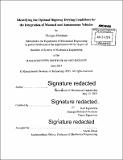| dc.contributor.advisor | Karl Iagnemma. | en_US |
| dc.contributor.author | Abraham, Zianga (Zianga Malisha) | en_US |
| dc.contributor.other | Massachusetts Institute of Technology. Department of Mechanical Engineering. | en_US |
| dc.date.accessioned | 2015-09-29T18:55:05Z | |
| dc.date.available | 2015-09-29T18:55:05Z | |
| dc.date.copyright | 2015 | en_US |
| dc.date.issued | 2015 | en_US |
| dc.identifier.uri | http://hdl.handle.net/1721.1/98951 | |
| dc.description | Thesis: S.B., Massachusetts Institute of Technology, Department of Mechanical Engineering, 2015. | en_US |
| dc.description | Cataloged from PDF version of thesis. | en_US |
| dc.description | Includes bibliographical references (pages 59-61). | en_US |
| dc.description.abstract | This thesis investigates the effect that the implementation of autonomous vehicles may have on the vehicle fleet through the design of a simulator in MATLAB that models human-driven and autonomous vehicles. The manned vehicle model, consisting of aggressive, normal, and cautious drivers, utilizes many of the same functions as the autonomous vehicle model. However, one characteristic difference between the two models is the reaction time. The manned vehicles have a reaction time of 0.8 seconds, while the autonomous vehicles essentially have a negligible reaction time. The two vehicle models were integrated into one simulator in order to identify the points at which society would begin to benefit from having autonomous vehicles on the roadways. Two cost functions, traffic flow rate and safety, based on the number of collisions, were optimized with respect to two parameters, fraction of autonomous vehicles and traffic density. From the plotted data, the critical points could be identified. The results suggest that once the autonomous vehicles comprise more than 40% of the vehicle fleet, an increase in the traffic flow rate will be observed. The results also suggest that once the traffic density exceeds 10 vehicles per 1280 M² , the traffic flow rate begins to decrease. The number of collisions increases with traffic density, and an exponential growth can be recognized, indicating a critical point. Unexpectedly, the number of collisions slightly increases with the fraction of autonomous vehicles. The increase in the number of collisions is possibly due to the accelerated speeds of the autonomous vehicles and a platooning effect. A significant amount of variation was detected within each data set implying that another measure of safety may be useful. | en_US |
| dc.description.statementofresponsibility | by Zianga Abraham. | en_US |
| dc.format.extent | 61 pages | en_US |
| dc.language.iso | eng | en_US |
| dc.publisher | Massachusetts Institute of Technology | en_US |
| dc.rights | M.I.T. theses are protected by copyright. They may be viewed from this source for any purpose, but reproduction or distribution in any format is prohibited without written permission. See provided URL for inquiries about permission. | en_US |
| dc.rights.uri | http://dspace.mit.edu/handle/1721.1/7582 | en_US |
| dc.subject | Mechanical Engineering. | en_US |
| dc.title | Identifying the optimal highway driving conditions for the integration of manned and autonomous vehicles | en_US |
| dc.type | Thesis | en_US |
| dc.description.degree | S.B. | en_US |
| dc.contributor.department | Massachusetts Institute of Technology. Department of Mechanical Engineering | |
| dc.identifier.oclc | 921147434 | en_US |
